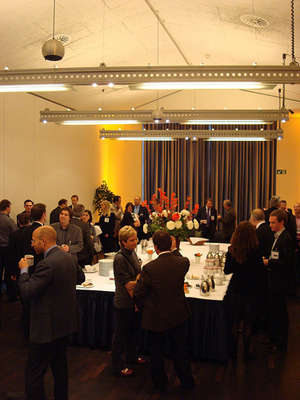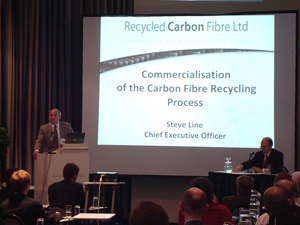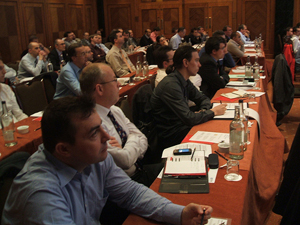
LCA reinforces need for recycling
The first ever Carbon Fibre Recycling and Reuse Conference, organised by Intertech Pira, was held in the Bergedorf district of Hamburg in early November. Over 50 delegates from all over the world attended the one and a half day conference, which featured over a dozen presentations on subjects such as an overview of the different recycling technologies available, operational challenges, and end user perspectives. The use of carbon fibre reinf

27th November 2009
Innovation in Textiles
|
Hamburg

The first ever Carbon Fibre Recycling and Reuse Conference, organised by Intertech Pira, was held in the Bergedorf district of Hamburg in early November. Over 50 delegates from all over the world attended the one and a half day conference, which featured over a dozen presentations on subjects such as an overview of the different recycling technologies available, operational challenges, and end user perspectives.
The use of carbon fibre reinforced composites has been growing steadily for several years, and this growth looks set to accelerate in the future as technology advances open up new end uses and markets. One industry analyst forecasts this growth to be from around 170 million lbs in 2009 to somewhere in the region of 270 million lbs by 2013. However, hand in hand with this growth comes the problem of how to process both manufacturing waste and end-of-life goods in an environmentally responsible way.
Dr. Steve Pickering, of the University of Nottingham, both chaired the conference and gave the opening presentation. His presentation looked at the various technologies available to recyclers, and concluded that there is no ‘one size fits all’ solution: for instance, processes suitable for waste/reject goods deliver very low degradation in key fibre properties (<3% for supercritical fluid processing), whereas processes better suited for ‘end-of-life’ material may reduce strength by 25%-50% due to mechanical damage and fibre oxidation.
Steve Line, CEO of the West Midlands based company Recycled Carbon Fibre Ltd., told delegates that his company had the world’s first continuous commercial scale carbon fibre recycling line, and posed the question of how to establish a baseline price for recycled carbon fibre. Despite the diverse nature of the feedstock, with little or no information on the strength properties of the original fibre, RCF claim to retain upwards of 90% of the strength of typical virgin carbon fibre.
 Bill Carberry, Boeing’s Airplane and Composite Recycling Program Manager, who is also a deputy director of the Aircraft Fleet Recycling Association (AFRA), made a number of interesting points. First among these, he stated that the members of AFRA recycled 220,000 tonnes of aluminium in 2008: as aluminium is replaced by (albeit lighter weight) composites in the next generation of aircraft, the carbon fibre recycling industry will be presented with a stiff challenge if it is going to keep pace with demand. Second, he stressed that whilst Boeing’s current developments were very much centred on composites, aircraft manufacturers would always use the best material available for the purpose and there was no guarantee that this will always be carbon fibre.
Bill Carberry, Boeing’s Airplane and Composite Recycling Program Manager, who is also a deputy director of the Aircraft Fleet Recycling Association (AFRA), made a number of interesting points. First among these, he stated that the members of AFRA recycled 220,000 tonnes of aluminium in 2008: as aluminium is replaced by (albeit lighter weight) composites in the next generation of aircraft, the carbon fibre recycling industry will be presented with a stiff challenge if it is going to keep pace with demand. Second, he stressed that whilst Boeing’s current developments were very much centred on composites, aircraft manufacturers would always use the best material available for the purpose and there was no guarantee that this will always be carbon fibre.
Day 1 closed with two complementary presentations from researchers at London’s Imperial College. Soraia Pimento is engaged in research into analysing failure mechanisms under different stress conditions, and explained that irregular alignment and density of recycled fibres were the main causes of the reduction in strength relative to virgin fibre. Silvestre Pinho’s work built on this primary research by developing models that will enable predictions of performance to be made. This information can then inform the design of reclamation/recycling systems to give the optimum outputs.
Pete George from Boeing’s Research and Technology division started day 2 with a look at some aircraft parts that might be made from recycled carbon. Obviously these would not include major structural assemblies, but might well be items such as armrests (a prototype was passed around the conference room) and overhead stowage bins. Pete George argued that the goal of recycling for the aircraft industry should be to reclaim material in a way that substantially retains the value and attributes of the original material and can be integrated into existing markets.
Moving from the aerospace sector into motor racing, James Meredith from Warwick University outlined the role of recycled carbon fibre in World F3rst, a sustainable Formula 3 racing car. In addition to ‘non safety critical’ bodywork parts such as the engine cover being made from recycled carbon, the car has a number of other sustainable credentials including a steering wheel made of Curran® - a material derived from the pulp of root vegetables - and a seat whose is base made from a woven flax fibre prepreg material covered in SoyFoam, a soya bean derived foam.
Continuing the automotive theme, Nick Warrior of the University of Nottingham spoke about his collaboration with Ford on the AFRECAR (Affordable Recycled Carbon Fibres) and HIRECAR (High Value Composites from Recycled Carbon Fibres) projects. These projects are looking into ways of resolving the problems of meeting the requirements of the end-of-life directive (which requires that 95% of all vehicle materials must be recycled by 2015) and developing affordable composites for motor vehicles. These projects have been able to produce some ‘demonstrator’ parts by, amongst other things, incorporating fibre in bulk moulding compounds. Agreeing with the findings of the Imperial College team, Nick Warrior stressed the importance of optimum fibre alignment as the key to added value recycled composites.
Building in additional safety, comfort and emission reduction features has increased the kerb weight of the average car by 20% since 1985, according to Bern Thoma of the Fraunhofer Institute. This makes the ‘lightweighting’ potential of composites a very attractive proposition to the industry: taking the whole of its life cycle into account, from raw material manufacturing through to recycling, around 85% of the CO2 emissions of a vehicle will come from its use, therefore even small savings in weight will have a marked effect on life cycle CO2 values.
 Only by sharing the cost and investment between generator and recycler can a sustainable revenue chain by established, said Thomas Hunter of carbon fibre recycler Firebird Advanced Materials. This presentation outlined the various sources of raw material, and how the different states it arrives at the recyclers in affect the recycling process. Hunter came to the conclusion that, until a means of automated sorting can be devised, the most cost effective way to sort scrap is at the point of generation, although how to incentivise primary manufacturers to do this was a real problem.
Only by sharing the cost and investment between generator and recycler can a sustainable revenue chain by established, said Thomas Hunter of carbon fibre recycler Firebird Advanced Materials. This presentation outlined the various sources of raw material, and how the different states it arrives at the recyclers in affect the recycling process. Hunter came to the conclusion that, until a means of automated sorting can be devised, the most cost effective way to sort scrap is at the point of generation, although how to incentivise primary manufacturers to do this was a real problem.
Tim Rademacker of CFK Valley Stade Recycling presented a well thought out SWOT analysis of recycled carbon fibres, pointing out the fact that demand for virgin carbon fibre running ahead of supply was a real opportunity. CFK are investing heavily in carbon fibre recycling technology, with a 1000 ton/annum plant due to come on stream in autumn 2010.
Jack Howarth of University of Sheffield (representing Technical Fibre Products) discussed ways of incorporating recycled carbon in fuel cell technologies and Electromagnetic Interference (EMI) applications, whilst concluding that many challenges lay ahead for the technology, whilst Joseph Heil of North Carolina State University updated the conference on Vacuum Assisted Resin Transfer Moulding, Bulk Moulding Compound and Injection Moulding technology.
The nature of the difficulties faced by recyclers was highlighted by Dr Jan-Michel Goseau of Adherent Technologies when he referred to carbon fibre reinforced composites as “intractable by design”. Referring to his organisation’s early attempts to recycle manufacturing scrap from a Boeing 787 he raised a laugh amongst the delegates by saying he was very confident about flying in a composite aircraft “but about recycling it, much less so!” He also revealed that Adherent plan to open a 100 ton/annum recycling facility in the near future.
As the conference closed, there was general agreement among the delegates that this should not be the last platform dedicated to the subject of carbon fibre recycling, although future editions may be incorporated into less highly specialized conferences.
 Our correspondent Steve Kay, is Business Development Manager at Bolton, U.K. based NW Texnet, a leading technical textiles cluster management organization.
Our correspondent Steve Kay, is Business Development Manager at Bolton, U.K. based NW Texnet, a leading technical textiles cluster management organization.

Business intelligence for the fibre, textiles and apparel industries: technologies, innovations, markets, investments, trade policy, sourcing, strategy...
Find out more